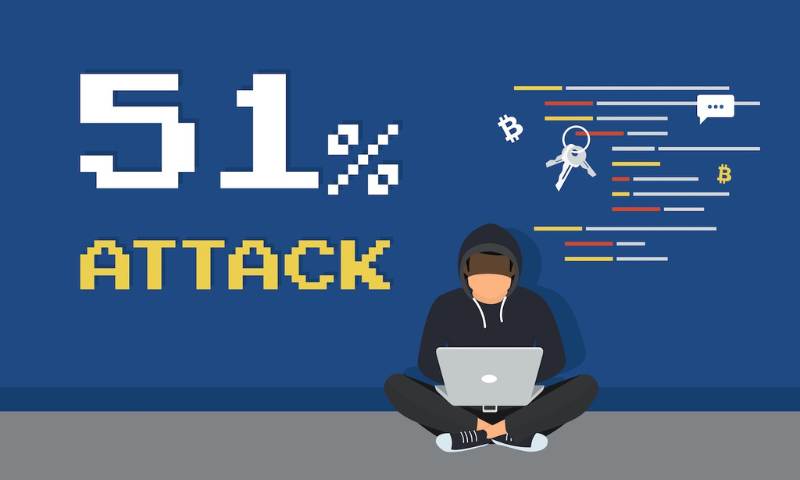51% Attack Explained: Could Your Crypto be at Risk?
Imagine a game where the majority calls the shots. Now, apply that to crypto. That’s where How does a 51% attack work? This attack lets someone control and bend a blockchain’s rules to their will. They get most of the network’s mining power, leading to chaos. They can stop new transactions, reverse ones they made, and double-spend coins. It’s a big deal that can shake the trust in cryptocurrency we all rely on so much. Let’s dive in and tear apart this ticking tech time bomb, so you know how to keep your digital dough safe.
Understanding the Mechanics of a 51% Attack
The Role of Majority Hash Power in Blockchain Security
Think of a blockchain like a team game where miners follow rules to agree on who wins. If you control the game by having over half the team, you can change the rules to your favor. That’s how majority hash power can shake blockchain security.
In a blockchain, each miner’s power is linked to their hash rate. This is like their “vote” in the network. More hash power means more say in which transactions get approved. It keeps things fair because no one should have over half the power. But if one miner gets over 50%, we call it a 51% attack. They can then stop new transactions from gaining confirmations or even reverse transactions (double spending, which we’ll talk about next). This tips the balance, putting the blockchain at risk.
Some might ask, “What if it’s a group of miners together, not just one?” This is miner collusion, where a group joins forces to get past that 50% mark. It’s dangerous because they can control the blockchain and harm its integrity. They could cheat the system by spending the same coin twice.
How Double Spending Exposes Blockchain Vulnerabilities
Double spending hits at the heart of cryptocurrency security. It’s like spending a ten-dollar bill twice in the real world, but with digital money. If a miner or group controls more than half the network, they can spend their cryptocurrency, then rewrite parts of the blockchain. This makes it look like the original transaction never happened.
But how can a miner gain such power? They’d need to get a massive amount of hash rate control. They’d buy a lot of equipment or join hands with others. This needs much money and effort, but it’s not impossible.
Here’s where the Ethereum network safety measures come in handy. Networks like Ethereum keep updating to prevent such attacks. For instance, moving from a proof of work to a proof of stake model. It changes the way security works, making it harder for attacks like these.
Securing Proof of Work blockchains means beefing up the network so attacks cost more than they’re worth. Keeping miners honest is also key. We need to watch for any sign of hash power piling up. Stopping miner collusion before it snowballs is a top task for any network.
Double spending attacks can shake trust in a digital currency. They can lead to users running for the hills, hurting its value. That’s why it’s crucial to keep everything transparent. We must show users their crypto is safe. Blockchain confirmation times also need to stay quick to keep users happy and make attacks less tempting.
Understanding these attacks helps us defend our digital cash. Building strong defenses against a 51% attack is part of keeping crypto safe. With knowledge and the right tools, we can make sure the blockchain stays as it should – open, fair, and secure.
The Impact of a 51% Attack on Cryptocurrency Networks
Valuation Fluctuations Following Network Attacks
A 51% attack strikes at the heart of a blockchain’s trust. When attackers gain most of the hash rate, they call the shots. They can stop new transactions or reverse ones they sent. This opens a door to double spending – spending the same coin twice. Imagine buying a cake and eating it, then getting your coin back to buy another. It seems unfair, doesn’t it? That’s how these attackers benefit.
This kind of attack shakes investor faith. When trust dips, so does value. News of an attack can cause panic selling. This drives prices down, hurting everyone on the network. So, your crypto may lose value after an attack.
Disruption Risks and the Health of Crypto Networks
51% attacks can cripple a cryptocurrency’s operations. Once attackers have control, they can block other people’s transactions. This creates a bottleneck. It’s like a busy highway turning into a one-lane road. Everything slows down, and users start to worry. They might look for other places to do their business.
These attacks also expose other risks in crypto networks. They show us where blockchain might be weak. It helps us fix these issues before they get worse. Many work on defending against these attacks. They make the network more robust and keep your crypto safe from harm.
People place great trust in blockchains as secure tech. Without this trust, the health of the entire network is at risk. We must stay on guard against 51% attacks to keep the crypto world secure and thriving.
Preventing and Mitigating the Risks of 51% Attacks
Enhancing the Security of Proof of Work Consensus Models
You’ve heard of hackers taking over networks, right? Well, blockchains can face this too. We call it a 51% attack. It’s a big deal in the crypto world. If a group controls most of the network’s mining power, they can mess things up, double spend, and stop others’ transactions. But we can fix this.
First thing’s first, miners need to play fair. We need to make sure no one’s hogging all the computing power. More miners should mean safer networks. Also, we can use better tech that flags when someone’s trying to grab too much power. This keeps everything in check and stops attacks before they start.
When we spot a miner or group getting too strong, we must act fast. We can tweak the network rules to make it harder for them to take over. It’s all about keeping power split up so everyone has a say. That’s what keeps things safe.
Early Detection and Response to Hash Power Centralization
If too much power gets in one place, it’s trouble. We’ve got tools to see this happening. They check how spread out the mining power is. It’s like having a high-tech watch guard. It spots danger early on.
The key to stopping these attacks isn’t just watching for trouble. We need plans ready to go when things look fishy. This means if a miner gets too strong, the network can do something about it quick. We can change how the network makes new blocks or give honest miners a hand.
To be super safe, we also check on how long it takes for transactions to become final. Keep that quick and it’s harder for attackers to cause harm.
Putting our heads together, miners and coders can make these ideas work. It’s all about teaming up to keep our crypto safe. Standing strong together means no bad guys can come in and turn things upside down.
We’ve got to be on the ball, always ready, and always improving. Then we can chill knowing our digital cash is safe.
Remember, good security is like a strong castle. It’s not just the walls but the guards who watch over them. So let’s keep building those walls higher and training our guards better. That way, we can all sleep sound without worrying about our crypto treasures.
The Future Landscape: Safeguarding Against Blockchain Exploits
Strengthening Decentralized Ledger Security
Picture a group of miners secretly join forces. They plan a 51 percent attack to control a blockchain. Understanding a 51 percent attack is simple: if someone controls over half of the mining power, they can mess with transactions. They can double spend, which means spending the same coin twice. That’s a no-go in crypto land.
Blockchain security folks, like me, dig into this stuff. We look at how blockchain works. Think of it as a team sport. Every player’s move is watched and verified by others. But what if one team gets too strong? They can start making their own rules. That’s where the blockchain vulnerability lies.
To stop these bad actors—or malicious miners—we need strong defenses. Networks must spread out the mining power or hash rate. We’ve got to keep it out of the hands of a few. Otherwise, they may start double spending and gaming the system.
I can’t stress enough how risky a 51 percent attack is. The moment trust is gone, the crypto’s value can plummet. That’s bad news for everyone with a stake in it. Double spending isn’t just a trick. It undermines the whole point of blockchain. We use crypto for its strong security. If that’s not there, why bother?
To prevent these attacks, we need to think ahead. Always. We must watch the hash rate like hawks. We can’t let it concentrate in few hands. That’s how we maintain the network attack line of defense.
Fostering Peer-to-Peer Network Resilience and Trust
Building trust is like crafting a strong chain, one link at a time. Each miner in the network acts as a link. They make sure not a single transaction is faked or reversed. This trust is key for a healthy crypto network.
Networks must be tough against attack vectors in crypto. Ways people can attack our crypto must be shut down tight. Keep the blockchain from splitting into blockchain forks. Make sure everyone plays fair.
We also watch for miner collusion. That’s when miners gang up to control the hash rate. This can lead to a blockchain consensus mechanism breakdown. We can’t have that. If they win, we see disruptions in blockchain and insecurity.
So, how do we avoid disaster? We foster peer-to-peer network strength. Encourage more folks to mine. Ensure they have equal chance to pitch in. This levels the playing field. And it prevents one group from ruling the roost.
Improving the blockchain confirmation times also helps. It keeps the system nimble and hard to attack. Think of it like a castle with guards always on the move. A moving target is much harder to hit.
Defense is about staying smart and one step ahead. We aim to stop 51 percent attacks before they even start. We guide developers to build better, safer systems. That’s the future I see—a shielded, robust crypto world where trust is king and security is the crown jewel.
We’ve explored how a 51% attack threatens blockchain security, leading to possible double spending and harming a cryptocurrency’s value. Safeguarding networks is vital. We can enhance security and detect threats early to keep our crypto safe. Trust in blockchain’s future rests on our shoulders; let’s build strong, resilient networks. Keep learning, stay aware, and support a secure crypto world!
Q&A :
What is a 51% attack in the context of cryptocurrency?
A 51% attack refers to a situation in blockchain technology, particularly in cryptocurrencies, where a single entity or group gains control of more than 50% of a network’s mining hash rate, or computing power. This level of control allows the attacker to disrupt the network by carrying out malicious activities such as double-spending coins, preventing transaction confirmations, or blocking other miners from mining blocks, thereby centralizing what is intended to be a decentralized network.
How can an attacker benefit from a 51% attack?
The main benefit an attacker could potentially gain from a 51% attack is the ability to double-spend cryptocurrency. Double-spending involves spending the same digital funds twice, which is normally prevented by blockchain technology. An attacker with majority control could reverse transactions after they have been completed, effectively allowing them to spend the cryptocurrency again. This undermines the integrity and trustworthiness of the cryptocurrency and can lead to financial gains for the attacker at the expense of others.
What cryptocurrencies are most vulnerable to a 51% attack?
Small-cap cryptocurrencies with lower hash rates are generally more susceptible to 51% attacks, as the cost to gain majority control of the network is significantly less compared to larger networks like Bitcoin or Ethereum. Cryptocurrencies that utilize proof-of-work (PoW) consensus mechanisms and have a smaller, less distributed mining pool are at a higher risk. The more decentralized the mining operations and the higher the hash rate, the more secure a network is against such attacks.
What measures are taken to prevent 51% attacks?
To prevent 51% attacks, several strategies are employed. These include increasing the network’s hash rate to make it more difficult for an entity to gain control, implementing more robust consensus mechanisms such as proof-of-stake (PoS), which often require not just computational power but also the ownership of a significant amount of the cryptocurrency itself, thus increasing the cost of an attack. Additionally, some cryptocurrencies use checkpointing and other methods to validate the authenticity of the blockchain, which can help in protecting against chain reorganizations resulting from 51% attacks.
Has a 51% attack ever been successful on a major cryptocurrency network?
While major cryptocurrencies like Bitcoin and Ethereum have not been successfully targeted by a 51% attack largely due to their high hash rates and robust security measures, there have been several instances where smaller cryptocurrencies have fallen victim to such attacks. This includes cryptocurrencies like Ethereum Classic, Vertcoin, and Bitcoin Gold. These successful attacks highlight the importance of network security and the potential vulnerabilities that come with decentralized consensus models, especially for lesser-known cryptocurrencies with smaller networks.


